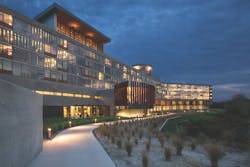Hotels embrace place
The $12.2 billion merger of Marriott International and Starwood Hotels & Resorts reflects an industrywide consolidation that has placed the keys to millions of the world’s hotel rooms into the hands of a few hospitality companies.
But rather than narrowing consumer options, this consolidation has actually had the opposite effect. The number of hotel brands and sub-brands continues to multiply, expanding at a breakneck pace as the largest hospitality players seek to attract and build loyalty with guests. Collectively, Marriott and Starwood now oversee 30 separate hotel brands, ranging from signature flags like Ritz-Carlton to newer select-service boutique brands such as Aloft, which targets global travelers.
“Ten years ago, prototypical brands were very consistent from market to market,” says Nate Gundrum, Director of Real Estate Development with Mortenson Construction. “Now, with the addition of new brands, you’re seeing larger hotel companies opening up to the idea of customizing a hotel to its site, neighborhood, and market rather than following a cookie-cutter approach where every brand had to look the same.”
With a vast assortment of choices, hotel providers aim to offer consumers a customized lodging experience that aligns with their lifestyle and budget.
“For the longest time, it was all about repetition and economies of scale,” says Keith Simmel, AIA, LEED AP, Principal of the Hospitality Studio at Cooper Carry in Atlanta. “Even though those things are still very important, we’re weaving more and more local flavor into a hotel so that it creates an experience unique to a specific place.”
That local experience is about far more than just offering trendy local cuisine or kitschy T-shirts in the gift shop. The 800-room Omni Nashville hotel, designed by HKS, is seamlessly integrated into the Country Music Hall of Fame and Museum on three levels. In the lobby area, visitors can view colorful posters being designed and printed at a production shop and gallery operated by Hatch Show Print Company, a local printer.
“Hotels have an opportunity to create a soulful experience that grounds itself in a place and leaves an indelible memory with guests,” says Nunzio DeSantis, FAIA, LEED AP, Director of the HKS Hospitality Group in Dallas. “And it isn’t just limited to the public spaces. It could be the way the guest room is fashioned, the quality of light, the materials, or the overall tenor of the space.”
To broaden a hotel’s appeal to multiple market segments, hotel developers are increasingly choosing to co-locate two or more complementary brands within the same hotel complex. At The Wharf, a $2 billion mixed-use waterfront community in Washington, D.C., a dual-branded hotel under construction combines a Canopy by Hilton and a Hyatt House into a dual-branded hotel with shared amenities.
“They’re two different flags, but not really in competition with each other,” says John Crump, AIA, LEED AP, Workplace Studio Leader at SmithGroupJJR in Washington, D.C. “Canopy is a select-service brand targeted to Millennials and single travelers and Hyatt House appeals to a business traveler or as an extended-stay hotel. The arrangement works well because people have access to the same amenities within the facility, but they can retire back to their rooms to meet their specific lodging requirements.”
A SHIFTING OF SPACE
Rising real estate costs and evolving guest preferences are inspiring a reshaping of hotel layouts to make the most productive use of interior space. Generally, guest rooms are getting smaller, while public spaces are increasing in size—a phenomenon similar to the office sector’s trend toward less “me” space and more “we” space.
“Guest rooms are where people sleep and get cleaned up to go out and experience whatever place they’re visiting,” says Caleb Mulvena, Principal at Mapos in New York. “We want the common spaces to help enhance that experience.”
Nowhere is this shift more apparent than in the hotel lobby, which has transformed from a narrow-use area that accommodates arrival and check-in activities to a dynamic living-room space and hub of diverse activity.
“We joke in our office that it’s not your parent’s Marriott hotel lobby anymore,” Simmel says. “It’s really a social gathering space, a social condenser.”
Lobbies are vital to maximizing revenue generation through a growing focus on food and beverage offerings. Cooper Carry capitalized on this trend with its 2016 acquisition of The Johnson Studio, an Atlanta-based restaurant designer. Their recent design collaborations include a new 325-key luxury hotel and conference facility under construction in Alpharetta, Ga. A restaurant forms the centerpiece of the lobby at this property, which anchors the city’s 1.1 million-sf Avalon mixed-use development.
Fitness centers also have been elevated from their traditional locations tucked away in a basement to prominent positions with generous square footage and scenic views to the outside. And rooftops are being repurposed into active amenity spaces.
“Rooftops are becoming one of the most important landscapes in the hotel,” says DeSantis. “They’ve also become some of the most active revenue-generating assets, whether they house bars, restaurants, meeting space, outdoor entertainment zones, or a pool.”
Technology continues to streamline the guest experience, from the efficient check-in and check-out process to the robust wireless infrastructure that supports seamless use of laptop and mobile devices.
“The days of running cable are gone,” says Rick Goldman, District Manager with PCL Construction in Orlando, Fla. “Now it’s more about knowing how much wireless capacity is enough.” Determining the amount of bandwidth required can be difficult, says Goldman, “as hotels are having to accommodate families of five, with each person having a device, sometimes two.”
Some hotels are striving to distinguish themselves by offering technology-centric amenities such as mobile tablets in guest rooms, while others are focused on providing a reliable technology infrastructure.
“Most people just want a clean room that accommodates a digital lifestyle. Give them high-speed WiFi and a place to charge their devices, and they’re off to the races on their own,” says Mulvena. “It’s really about creating hotels that deliver highly ‘Instagrammable’ experiences that people will have fun sharing.”
REPOSITIONING EXISTING PROPERTIES
To keep pace with the flurry of new hotel properties coming online, existing properties are reimagining their facilities to enhance their appeal to potential guests.
“Some of the most interesting work is on major renovations of landmark hotels or hotel conversions from a completely different building type,” says Randa Tukan, IDC, LEED AP BD+C, Director of Interiors at HOK in Toronto. “Many of these projects involve a major rethinking of the space available, which makes the solution a lot more interesting and unpredictable.”
HOK recently completed a $180 million renovation of the Intercontinental New York Barclay, a luxury hotel that originally opened its doors in 1926 as part of the Grand Central Terminal expansion. “Within this historic space, we were able to carve out a lot more public spaces by repurposing house spaces and storage spaces into new multipurpose areas,” Tukan says.
Creating a sense of surprise is a priority for many hotel developers, adds Tukan. “A few years ago, a sense of familiarity was important for helping people feel more secure,” she says. “The trend now is the complete opposite. Because of our constant exposure to new ideas and information—real or virtual—we all yearn for experiences that are fresh and different.”
In Orlando, the Lake Nona Residence Inn and Courtyard hotel development was under construction when Tavistock Development decided to convert a floor of both hotels to Stay Well guest rooms. Introduced by Delos, creator of the WELL Building Standard, these hypoallergenic rooms offer evidence-based health and wellness features to help travelers live healthy lives while on the road. Amenities include circadian lighting, air purifiers, filtered water, acoustic enhancements, and low-VOC materials that limit the emission of toxins and chemicals.
“These hotels are located a short walk from a large children’s hospital and a VA hospital, so the developer saw this as a way to promote healthiness in an area where people were already acutely aware of health components,” Simmel says.
In many ways, today’s hotels are recommitting to their fundamental mission of providing exceptional service to guests.
“There seems to be a return to hospitality in the hospitality industry,” says SmithGroupJJR’s Crump. “Hotels have always strived to provide an environment of welcoming guests and giving them a great experience, but I think that’s been lost over the years, so brands are refocusing on enhancing the overall guest experience.”


